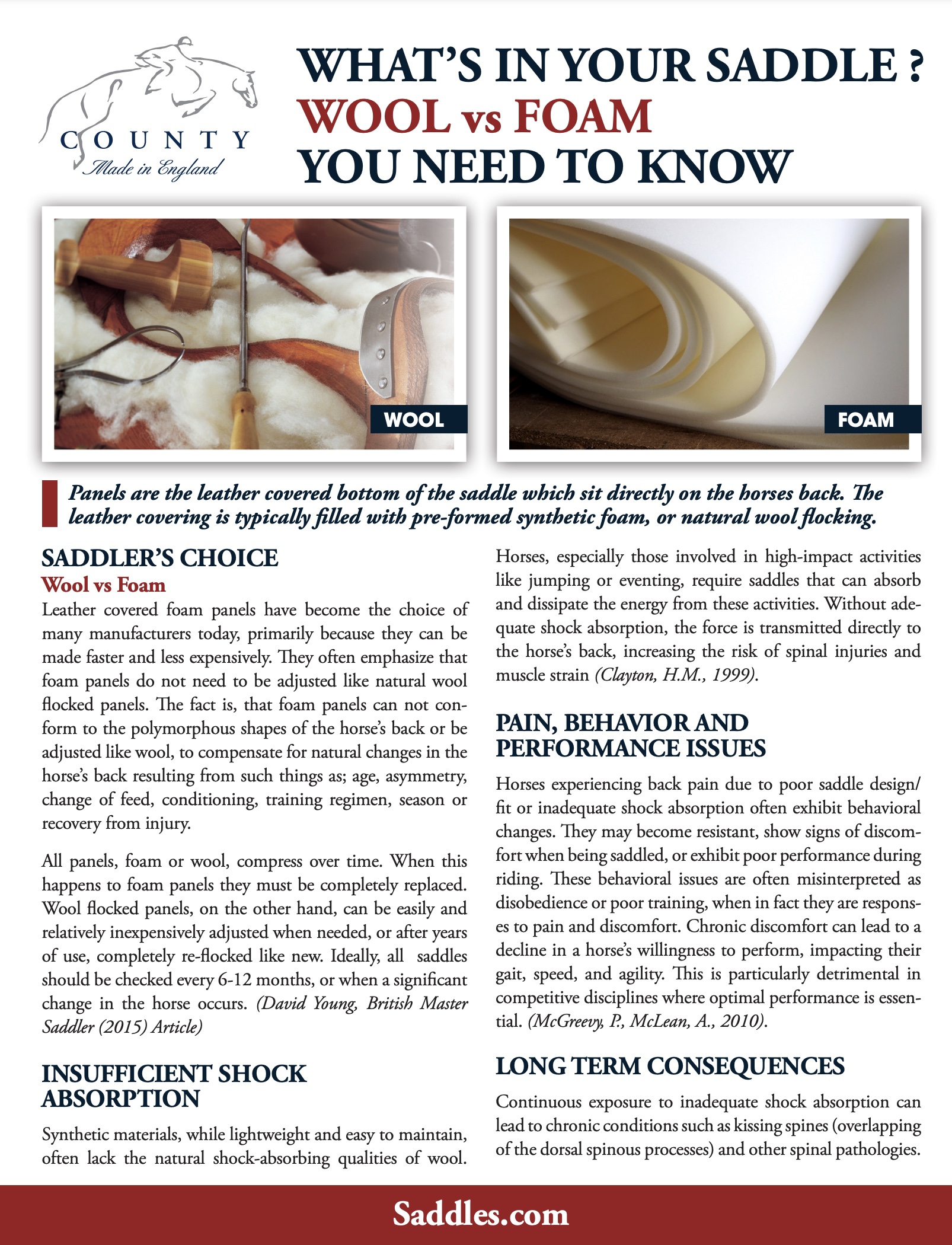WHAT'S IN YOUR SADDLE? YOU NEED TO KNOW


WHAT’S IN YOUR SADDLE?
WOOL vs FOAM
YOU NEED TO KNOW
SADDLER’S CHOICE
Synthetic trees and leather-covered pre-formed foam panels have become the choice of many manufacturers primarily because they can be made much more quickly and inexpensively. They often emphasize that preformed foam panels do not have to be adjusted like wool flocked panels. The fact is, that preformed foam panels cannot be adjusted like wool. Foam panels do not conform to the polymorphous shapes of a horse’s back, and unlike wool, cannot be adjusted to compensate for natural changes in the horse such as age, asymmetry, condition, feed, training regimen, season, or recovery from injury. All panels, foam or wool, compress over time. When this happens to foam panels they must be completely replaced. Wool flocked panels, on the other hand, can be easily and relatively inexpensively adjusted when needed or, after years of use, completely re-flocked like new. (David Young, British Master Saddler, 2015 Article)
INSUFFICIENT SHOCK ABSORPTION
Synthetic materials, while lightweight and easy to maintain, often lack the natural shock-absorbing qualities of wool. Horses, especially those involved in high-impact activities like jumping or eventing, require saddles that can absorb and dissipate the energy from these activities. Without adequate shock absorption, the force is transmitted directly to the horse’s back, increasing the risk of spinal injuries and muscle strain (Clayton, H.M., 1999).
PAIN, BEHAVIOR AND PERFORMANCE ISSUES
Horses experiencing back pain due to poor saddle design/fit or inadequate shock absorption often exhibit behavioral changes. They may become resistant, show signs of discomfort when being saddled, or exhibit poor performance during riding. These behavioral issues are often misinterpreted as disobedience or poor training, when in fact they are responses to pain and discomfort. Chronic discomfort can lead to a decline in a horse’s willingness to perform, impacting their gait, speed, and agility. This is particularly detrimental in competitive disciplines where optimal performance is essential. (McGreevy, P., McLean, A., 2010).
LONG TERM CONSEQUENCES
Continuous exposure to inadequate shock absorption can lead to chronic conditions such as kissing spines (overlapping of the dorsal spinous processes) and other spinal pathologies. These conditions can severely affect a horse’s performance and quality of life, often requiring extensive veterinary treatment and rehabilitation (Dyson, S.J., 2000).
POOR BREATHABILITY AND HEAT ABSORPTION
One of the advantages of natural materials like wool is breathability. They allow air circulation, which helps to keep the horse’s back cool and dry. In contrast, synthetic/foam materials tend to trap heat and moisture, creating a hot and sweaty environment under the saddle. This can lead to skin irritation, heat rashes, and sores. Prolonged exposure to heat and moisture can cause bacterial and fungal infections. Saddle sores and girth galls are common issues that arise from poor breathability. These conditions not only cause pain but can also lead to behavioral issues as the horse attempts to avoid further discomfort (Mills, D.S., et al., 2005).
PRESSURE POINTS
One of the most significant issues with foam-paneled saddles is their inability to provide a custom fit. Unlike wool flocked saddles that can be adjusted and tailored to fit the horse’s back contours, foam-paneled saddles are often designed with a one-size-fits-all approach. This lack of customization can lead to uneven pressure distribution across the horse’s back, causing discomfort and pain. Poorly designed or fitted saddles, whether synthetic or not, often create pressure points. These are areas where the saddle exerts more force on the horse’s back, which can lead to bruising, soreness, and muscle atrophy over time. Research shows that continuous pressure on specific areas can lead to chronic pain and long-term damage to the horse’s musculature and spine (Harman, J.C., 2004).
ECONOMIC COST AND DURABILITY
While some foam-paneled saddles are priced inexpensively, others are priced at the top of the premium market. But there is more to consider than just the initial cost e.g., durability and long-term use. Whereas a well-designed saddle using quality natural materials may improve performance and reduce vet bills and downtime, a poorly designed saddle may significantly increase those costs. While foam-paneled saddles are touted for their low maintenance, they often do not hold up well over time compared to high-quality wool flocked saddles. The synthetic materials can degrade, become brittle, or lose their structural integrity. This deterioration can exacerbate the problems associated with poor saddle fit.
CONCLUSION
The choice of saddle is a crucial aspect of equine management that directly affects the health, happiness, performance, and indeed your relationship with your horse. While foam-paneled saddles offer certain conveniences, their inability to provide a customized fit, adjustability, adequate shock absorption, breathability, and durability, make them less suitable for maintaining optimal equine health. Investing in a well-designed and fitted, high-quality saddle, preferably with natural wool flocking, can prevent a host of health problems and ensure a more comfortable and harmonious riding experience. At the very least, you owe it to your horse and yourself to compare the difference.
REFERENCES
- Clayton, H.M. (1999). Conditioning Sport Horses. Equine Research Publications.
- Dyson, S.J. (2000). Diagnosis and management of lameness in the horse. W.B. Saunders.
- Harman, J.C. (2004). The Horse’s Pain-Free Back and Saddle-Fit Book. Trafalgar Square Publishing.
- McGreevy, P., McLean, A. (2010). Equitation Science. Wiley-Blackwell.
- Mills, D.S., et al. (2005). The Domestic Horse: The Origins, Development, and Management of its Behaviour. Cambridge University Press.
- David Young, British Master Saddler (2015) Article
SCHEDULE YOUR TEST RIDE TODAY!
Recent Posts
-
SADDLE FITTING CLINIC
29th Nov 2025 -
SADDLE FITTING CLINIC
7th Nov 2025 -
